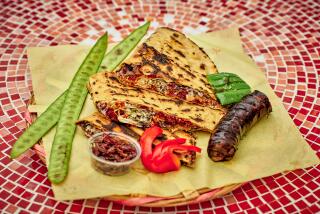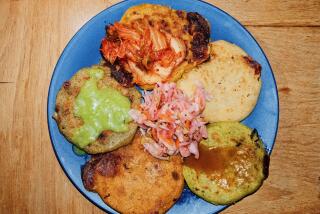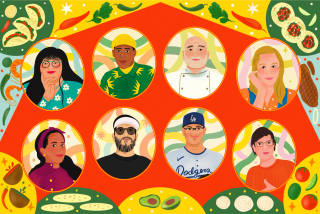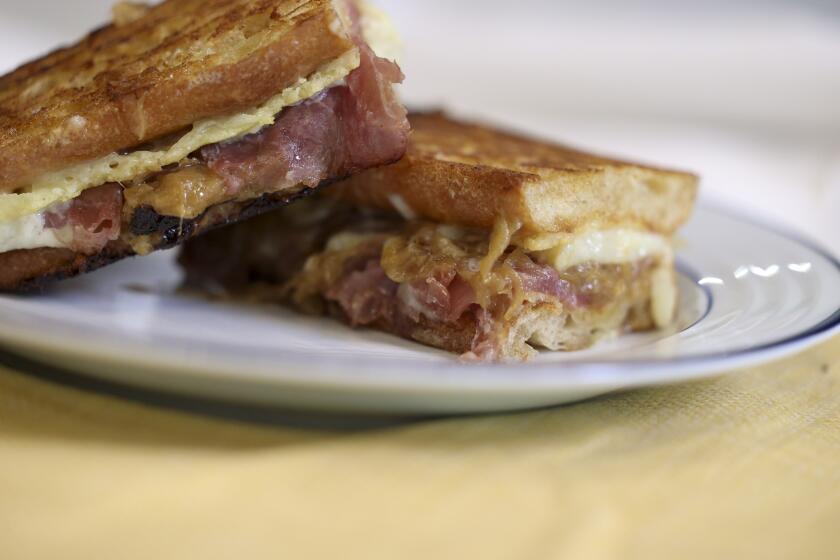Trip to Peru adds heat to Hanukkah recipes

Latkes a la huancaina (latkes with Peruvian pepper and fresh cheese sauce).
It wouldn’t be Hanukkah without papas a la huancaina and causa limena.
Peru may be one of the last places people associate with Hanukkah, but when we visited that country a few months ago, the potato lovers’ holiday was very much on our minds. After all, potatoes originated in that part of the world, and more than 4,000 varieties of spuds grow there. With their long experience using the tubers, cooks in Peru have developed delicious potato dishes that happen to be perfect for Hanukkah.
One of the dishes we enjoyed most in Peru was papas a la huancaína, boiled potatoes coated with a creamy sauce made of queso fresco and yellow chiles. When we tasted it, we imagined that the sauce would go well with potato pancakes, and so when we returned home we made latkes a la huancaína.
Another potato appetizer we loved was causa limeña, which we first ate at La Mar Cebichería in Lima, where it was made of patties of mashed yellow potatoes topped with lime-flavored chicken salad and a colorful garnish of avocado, tomato and hard-boiled egg. Causas in different varieties were everywhere, from casual eateries in market halls to delis of supermarkets to elegant restaurants.
They come as patties served with all kinds of toppings and fillings. Often the potato mixture was layered with the filling in a loaf pan and sliced like a terrine. Sometimes it was spread with the filling and rolled up, and occasionally it was shaped in rounds and sandwiched with the filling using individual pastry rings.
Both causa and huancaína sauces are flavored with ají amarillo, which means “yellow chile,” although usually this finger-shaped chile is actually orange. These peppers are sweet, with mild to medium heat. At Los Angeles markets that carry Latin American foods, the peppers can be found frozen whole, in jars as pepper paste or in brine, and as dried chiles labeled “ají mirasol.”
In using these chiles, we found that the degree of heat varies from one pepper to another. Ricardo Zarate, chef-owner of several Peruvian restaurants in Los Angeles and Santa Barbara, has a useful tip for getting around this. He removes the seeds and membranes and purées it with a little good olive oil so you can add it to taste. Prepared this way, it will keep in a jar in the refrigerator for a couple of weeks.
When we came across a street vendor in Lima skillfully forming and frying picarones, ring-shaped fritters made with sweet potatoes, we decided to make a similar sweet treat for Hanukkah. To make simpler sweet potato fritters, we used a French technique: We mixed sweet potato purée with choux pastry, the quick dough used for making cream puffs. With our fritters, we serve the same clove-scented piloncillo (cone sugar) syrup that is drizzled over picarones.
Somehow our fritters turned out resembling the fried spherical pastries called buñuelos, which Sephardim in several countries serve during Hanukkah.
Levy is the author of “1,000 Jewish Recipes” and “Faye Levy’s International Vegetable Cookbook.”
More to Read
Eat your way across L.A.
Get our weekly Tasting Notes newsletter for reviews, news and more.
You may occasionally receive promotional content from the Los Angeles Times.










